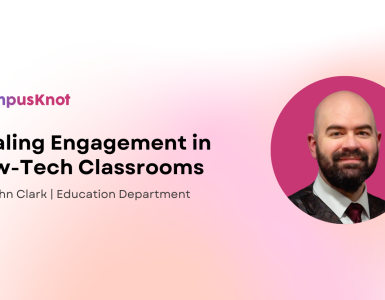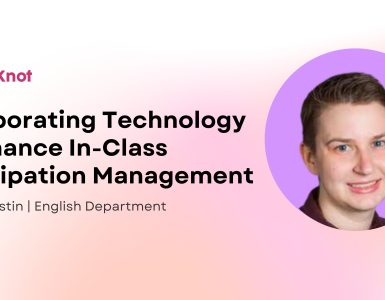At a Glance
- Faculty: Dr. Alexa Joubin
- Course highlighted in the study: Critical Theory Class
- Institution: George Washington University
- Class Sizes: 29–34 students
- Duration: Fall 2024 – Spring 2025 (ongoing use)
Dr. Alexa Joubin wears many hats at George Washington University. She’s a Professor of English, Women’s, Gender and Sexuality Studies, Theatre, International Affairs, and East Asian Languages and Cultures.
Her teaching often sits at the crossroads of culture, performance, and technology, where she asks her students not only to analyze texts but to understand how stories evolve across time.
Dr. Joubin’s passion for technology and innovation has guided her work as co-director and co-founder of the Digital Humanities Institute, where she has spent years assessing digital artifacts’ impact on our society, particularly in higher education.
The Challenge
Even with her deep background in digital pedagogy, she began noticing a growing tension in her Critical Theory class, students were using AI to write faster, not think deeper.
The challenge wasn’t about banning AI or resisting change, it was all about encouraging creativity and critical thought in an time where AI tools are just a click away.
Dr. Joubin noticed that students were increasingly leaning on AI in unproductive ways, summarizing readings, auto-generating outlines for research projects, or using templates that stripped away their unique voices.
What she needed was a way to spot meaningful patterns in student work, to see who was experimenting, who was stuck, and how ideas evolved over time, all without losing the spontaneity of live discussion in class.
When students submit writing during class, it is not humanly possible for the instructor to read them all on the spot for in-class discussion. Therefore, I use CampusKnot’s summaries of students’ in-class discussion posts to identify “outliers” in positive and negative contexts. Some “outlier” opinions reflect students’ creativity and ability to think outside the box. These posts could inspire other students.
The Initial Set Up
Dr. Joubin’s goal was clar, she needed to find a way to spot meaningful patterns in student work without losing the human element of learning and spending time doing so in the class.
So, she joined the CampusKnot community during the Fall semester of 2024, bringing it into her Critical Theory class of 30 students. Her plan was deliberate:
- Use Discussion Feeds for short, in-class writing assignments
- Launch Polls to surface misconceptions and spark reflection
- Track Attendance not as a checkbox, but as a measure of engagement
She wanted quieter students to have a voice and confident ones to find new angles for expression. The results for the first time use of the CampusKnot.
During that first semester, there were over 2,000 interactions recorded on CampusKnot, with a consistent 75% engagement rate and an 88% attendance rate, a strong start that hinted at something deeper taking shape
The Current Set Up
After seeing those early results, Dr. Joubin doubled down. She began every class with a short writing warm up activity, typically taking students a few minutes to complete. Dr. Joubin was turning what once felt like an assignment exercise into powerful diagnostic tools.
She explains:
AI is a pattern recognition tool. I use it to identify anomalies in students responses during in-class writing clinics.”
These “anomalies” or unexpected connections, bold interpretations, or even misunderstandings, became opportunities for richer dialogue. She encouraged students to use AI not as a ghostwriter, but as a mirror for their own thought process. In her words,
I emphasize the fine tuning of research questions as an iterative process. Students use AI to simulate perspectives of communities they are not familiar with.”
By the next semester, her class had logged over 3,000 interactions, with engagement climbing to 92% and attendance holding steady at 91%. But the numbers only tell part of the story.
What changed most was the quality of participation, students weren’t just completing tasks; they were questioning, comparing, and imagining together.
The Solution:
Dr. Joubin introduced CampusKnot’s AI-powered teaching assistant tools as a creative partner, not a replacement for human connection and creativity.
AI is a “third party” who is present in class. This is useful to break up the homogeny of the class consisting of students from similar backgrounds and in the same age group.
Here’s how Dr. Joubin uses AI:
- She introduced the CampusKnot Feeds to instantly surface “outlier” posts, those unusually insightful or off-track contributions that can become teachable moments.
- Students used AI to simulate perspectives from other cultures or generations, breaking away from echo chambers of familiar thought.
From her experience Dr. Joubin mentioned that her motivation for using the software was the real-time component of the AI tools.
CampusKnot excels in live, in-person, real-time interactions and facilitating communication in a large group. Other AI tools are primarily designed for one-on-one interactions.
Dr. Joubin’s Mantra?
“AI is a fictional agent, not a source of knowledge. We use it to spark curiosity, not shortcuts.”
Why it Matters?
For Dr. Joubin, AI isn’t about efficiency, it’s about depth. She’s using technology to make learning meaningful.
One moment stands out vividly in her mind. During a class discussion, CampusKnot’s summaries highlighted a student’s unconventional interpretation of a text. Instead of dismissing it, Dr. Joubin turned it into a class-wide exploration. That single post sparked a debate that carried into the next week, inspiring others to take creative risks in their writing.
She believes that:
- AI should add voices, not provide definitive answers.
- Faculty can design creative uses of AI that move beyond productivity and automation.
- Students learn best when ambiguity and difficulty are part of the process, not obstacles to avoid.
- AI should never be about automation in higher education.
Since adopting CampusKnot, Dr. Joubin has seen a cultural shift in her classroom:
- Attendance improved: students show up prepared, knowing that in-class writing shapes their understanding.
- Student voices deepened: responses became more original, imaginative, and personal.
- Dialogue grew richer: AI surfaced unexpected perspectives that challenged the sameness often seen in group discussions.
Advice for Faculty
Dr. Joubin’s classroom reminds us that technology doesn’t have to replace the human experience, it can reveal it.
“Don’t use AI for automation. Use it to open doors to perspectives students haven’t yet imagined. CampusKnot helps you do that in real time.”
Looking Ahead
As she continues her work, Dr. Joubin hopes to:
- Bring more diverse voices into her classroom through AI simulations
- Foster metacognitive awareness to help students think deeply
- Challenge learners to redefine their research as a creative process, even when using AI
CampusKnot, for her, isn’t just a tool, it’s a conversation partner helping turn the humanities classroom into a space of continuous discovery.




